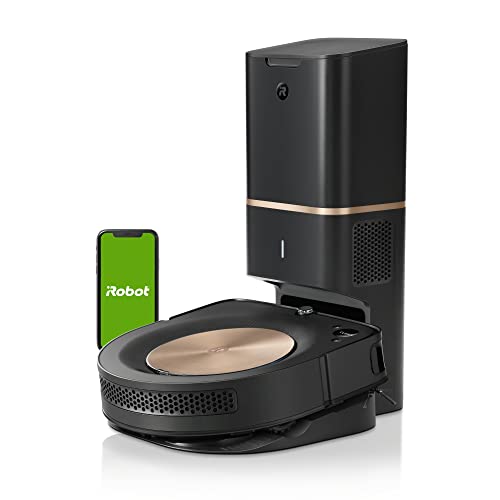 Robot vacuum cleaners require less maintenance. However, they have to be regularly emptied (and washed if the manufacturer says it's acceptable) and wiped down to remove hair from their brushes.
Robot vacuum cleaners require less maintenance. However, they have to be regularly emptied (and washed if the manufacturer says it's acceptable) and wiped down to remove hair from their brushes.Models equipped with smart mapping capabilities that allow you to view an interactive map of your home and allow you to establish no-go zones are ideal. Think about models that distinguish between pet hair and dirt if you own pets.
They're more efficient
If you're someone with only a short amount of time to maintain and clean your home, then a robotic vacuum is an excellent investment. While they're not able to substitute for an upright or canister vacuum cleaner, they will significantly reduce the amount of dust and dirt in your home. They also aid in cutting down on the amount of allergens and bacteria. They are more quiet than traditional vacuums, however they still require some maintenance.
Many robotic vacuum cleaners have filters that need to be cleaned frequently. Batteries will also need to be replaced. Certain models come with HEPA filters that reduce allergies and also capture smaller particles. These filters should be changed every 3 to 4 cycles or as per the manufacturer's guidelines.
Robot vacuums are frequently feared for their potential to harm furniture, walls and other items. However, these worries are unfounded since most models can be programmed to avoid specific areas of the home and are able to create virtual walls that prevent them from entering restricted areas.
Most robot vacuums come with sensors built-in that can recognize the type of floor surface and adjust the settings to match. This lets them clean a variety of surfaces, such as carpet, wood and tile. They can recognize obstacles and stairs and will change their direction if they encounter them.
Most robots clean your home by moving between them in a systematic manner. Certain models can also be used as robot mops. My experience with mopping capabilities of these machines is not stellar.
They're more practical
Robots can be operated on their own and are not plugged in, unlike traditional vacuum cleaners, which require plugging in an to an outlet. They're usually quiet, and won't disturb your sleep. Many are programmable to clean when you're not home.
Most robots are also much smaller than a stick vacuum, so they require less space in your home. They are easy to store under your bed or in your closet. You can even carry them around from room to room.
Certain robots come with self-emptying features, so you won't need to empty the dustbins manually after every cleaning session. And if you have a robot that can mop, it will typically have a large water tank that can go for months without having to be empty.
The machines utilize sensors to detect changes in the floor surface and automatically adjust their settings for the best results. This means that there is no requirement to pick between carpet, hardwood or tile, and lets them clean your entire house in one session.
The back-andforth motion they use is similar to the way that people move when cleaning rooms, which ensures that every corner and crevice is accounted for. Advanced models can use lasers or cameras to create maps in real-time to help them navigate around furniture and obstacles.
Lastly, most robots can charge themselves and return to their charging station when they need to be replenished. This gives you more time to focus on other tasks or spend your spare time doing something that you enjoy. You can control your smart home devices with an app for your smartphone, as they are connected to Wi-Fi.
It is important to keep in mind that robot vacuums are more expensive than standard stick vacuums, and don't come with the same warranty as traditional appliances. Typically, the warranties on these machines are limited to a single or two years, which isn't too long.
You can do a lot more with them
The benefit of a robotic vacuum cleaner is that the cleaning can be completed without the involvement of the user. There's no cord or hose to deal with, and you can operate the device using a remote control or smartphone app. A lot of them can be programmed to wash themselves, making them perfect for hands-free daily cleaning.
If you own smart home devices like Amazon Alexa or Google Assistant you can also control robot vacuums by voice commands. This allows those who are elderly or have mobility issues to use the robot vacuums. Depending on the model that you choose, some robot vacuums will also map out your floor plan and allow you to choose specific rooms that you'd like them to clean through the app or by voice commands.
Robots are quieter than canister, upright or handheld vacuums. Instead of cords that have to be moved around or stuck in electrical wires they use batteries. They do not require physical plugging in and unplugging from room to room. They're generally quieter too and some operate at the same level of noise as a refrigerator humming. They are perfect for families with sensitive members, such as those with pets or children who are scared of vacuums that are traditional.
Another benefit of robot vacuums is that they generally require less maintenance than conventional machines. They are smaller and require less space. They don't need cords or hoses. Most models come with dirt bins or bags that must be emptied regularly and the brush rollers need to be cleaned frequently. Generally, though, robots only require power to be turned on and placed in the space they're supposed to clean to be effective.
Like any other technology, however, there are drawbacks to robot vacuum cleaners. One of the major disadvantages is that they cost more than other vacuum cleaners. They are also slower to complete the task than the conventional models. While the majority of robots won't slide down the stairs or knock your favourite decor over, they are still susceptible to getting blocked and becoming stuck.
They're more expensive
Robots can be costly, especially if you choose the latest models that have advanced features. If you're willing more, a premium model may save you money over time. Budget robo-vacs for instance, have dustbags with smaller brushes that need to be changed more frequently than their more expensive counterparts. This can add up over time and can increase the cost of owning.
A lower-end model is more likely to fail and go rogue than a premium model. Another hidden cost is the requirement to replace motors and batteries or pay for repairs.
In comparison, premium models have a wide range of advanced features that make them more efficient and easy to use than traditional vacuums. Features such as advanced navigation, object recognition and mopping are now standard among robot vacuums. You'll also notice that more expensive models have a bigger battery capacity, have a longer life and are constructed from higher quality materials.
While robot vacs are fantastic for general cleaning, they're not magical: Depending on the model you pick, it may still struggle to reach tight corners or clean textured floors. In these situations, adult supervision is required and a thorough manual cleaning.
 Robotic vacs can also be programmed to clean at certain times by using an app for smartphones. This is a wonderful convenience for homeowners who are busy. The Robot Vacuum Mops vacs can be programmed by a smartphone application to clean at certain times. This is a great convenience for busy homeowners. However, they're not the same as a regular vacuum or mop, and you should still keep your home clean by regularly mopping and sweeping. You will achieve the best results with your robot vacuum if you utilize an excellent mop, a microfiber cloth and a bucket filled with water.
Robotic vacs can also be programmed to clean at certain times by using an app for smartphones. This is a wonderful convenience for homeowners who are busy. The Robot Vacuum Mops vacs can be programmed by a smartphone application to clean at certain times. This is a great convenience for busy homeowners. However, they're not the same as a regular vacuum or mop, and you should still keep your home clean by regularly mopping and sweeping. You will achieve the best results with your robot vacuum if you utilize an excellent mop, a microfiber cloth and a bucket filled with water.








